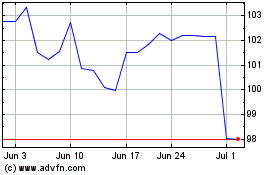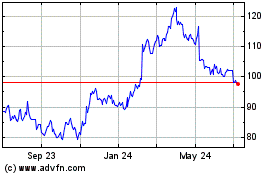By Dana Mattioli, Sahil Patel and Patience Haggin
Amazon.com Inc. and Walt Disney Co. are at loggerheads over
terms for carrying the entertainment giant's apps in Amazon's Fire
TV devices, a dispute that highlights the new power struggles
emerging in the streaming economy.
Amazon is pushing for the right to sell a substantial percentage
of the ad space on Disney apps, and Disney has so far resisted,
according to people familiar with the situation. Some of these
people say they are optimistic the companies will reach an
agreement. If they don't, Disney apps could be removed from Fire
TV, the second-largest distributor of streaming TV apps. Disney has
several apps, including for networks such as ABC, ESPN and Disney
Channel.
The dispute is one reason Fire TV has no deal in place to carry
Disney+, a coming Disney streaming-video service set to launch Nov.
12, the people familiar with the situation said. The deadline for
the talks wasn't clear.
Amazon's Fire TV is an internet-connected streaming-media player
that lets users stream content to their TVs from a range of apps,
including Amazon's own Prime Video, Netflix Inc., Sling TV and
offerings from a host of TV networks. It had 29% of the U.S. market
for streaming-media boxes in the second quarter, according to
Strategy Analytics, behind only rival Roku Inc.
The dispute highlights the complicated and sometimes tense
relationships between streaming-video distributors and content
providers. Fire TV, Roku and other companies offering such set-top
boxes or plug-in "sticks" have become vital hubs for reaching
consumers who stream media, and are increasingly playing the role
cable companies have played in traditional TV.
For years, cable providers have worked out arrangements with TV
channels to carry those networks. The channels get a portion of
consumers' monthly cable fees, and the cable providers often get
access to a portion of the ad time on the networks. Likewise, the
new-era streaming distributors have their own asks when they
negotiate carriage of streaming apps, such as a portion of the
content company's advertising or subscription revenue.
One big difference: Cable operators in the U.S. each cover a
specific geographic footprint, and TV programmers must negotiate
with each of them, under the threat that if a deal isn't reached
channels could be blacked out in those areas. In streaming,
channels can distribute their programming nationwide through a
number of set-top box players, and new entrants recently joined the
fray, including Comcast Corp.'s Flex and a Facebook Inc. device
called Portal.
"The traditional negotiations between cable operators and media
companies are the most vicious negotiations that I've ever been
exposed to. And now you see that world colliding with these tech
behemoths," said Steve Shannon, chief executive of Tetra TV, which
operates a marketplace for ads on streaming video.
People close to the Disney-Amazon situation said it isn't as
acrimonious as a traditional cable-carriage dispute. Spokeswomen
for Amazon and Disney declined to comment.
Streaming-media device makers have had fights among themselves
for several years. Until this year, for example, Fire TV devices
didn't have Google's official YouTube app, while Google's
Chromecast device didn't offer the Amazon Prime Video app.
Now, the battles are taking on higher stakes as entertainment
companies like Disney, facing stagnating pay-TV businesses, place
greater importance on reaching audiences on digital platforms and
increasingly are competing with tech giants. Disney+, for example,
will go up against Amazon's Prime Video in the marketplace, as will
forthcoming streaming services from AT&T Inc.'s WarnerMedia and
Comcast's NBCUniversal.
When Fire TV first launched, it allowed a number of media
companies to have apps on its platform without sharing any
advertising revenue, people familiar with the situation said. But
lately Amazon has been tightening its proposed terms in discussions
with certain programmers, the people said.
Amazon's push for more ad revenue from its partners is part of a
wider effort to better monetize businesses outside of the company's
profit engine, cloud computing arm Amazon Web Services.
Now, Amazon often starts out asking for around 40% of the ad
inventory from programmers, and negotiations often bring it down to
30% or 20%, according to people with knowledge of the company's
deals.
Well-known apps have the leverage to barter for more favorable
terms. Disney believes its popular apps -- and the coming launch of
Disney+ -- give it substantial clout, and the company hasn't been
keen to give up any ad inventory to Amazon, people familiar with
the company's deliberations said.
Recently, the two sides have discussed a proposal in which
Disney would give up 10% of its ad inventory, the people said.
Roku does business in a similar way. It often asks for 30% of
the ad inventory in channels it carries -- a starting point for
negotiations, said a person familiar with the matter. YouTube, the
second most-watched channel on Roku, shares none of its ad
inventory with Roku, according to people familiar with the
matter.
Some subscription-oriented services pay Roku a one-time "bounty"
when people sign up for the service through a Roku app, while
others may pay on a recurring basis. Hulu, the Disney-controlled
streaming service, gives Roku about 15% of the subscription revenue
from customers who signed up for the service through Roku, a person
familiar with the arrangement said.
Though Disney+ won't have ads, the discussions with Amazon to
carry it on Fire TV gave the tech giant an opportunity to revisit
advertising terms for various other Disney apps. Disney won't want
to have the service's distribution curtailed at launch, and Amazon
won't want to miss out on offering a service that will include
classic Disney movies, a lineup of Star Wars and Marvel content,
the full catalog of "The Simpsons" and more.
Disney has said Disney+ will be available to stream on Apple TV,
Android devices, Chromecast, iPads and iPhones, PS4, Roku, and Xbox
One.
Write to Dana Mattioli at dana.mattioli@wsj.com and Patience
Haggin at patience.haggin@wsj.com
(END) Dow Jones Newswires
October 03, 2019 12:02 ET (16:02 GMT)
Copyright (c) 2019 Dow Jones & Company, Inc.
Walt Disney (NYSE:DIS)
Historical Stock Chart
From Mar 2024 to Apr 2024

Walt Disney (NYSE:DIS)
Historical Stock Chart
From Apr 2023 to Apr 2024
